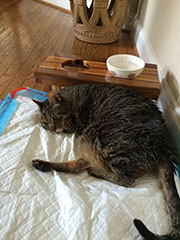Services
Pain Management
 Over the years, we have had the privilege to help many families in the care of their pets. One of the most common questions that families have as their pets age is whether or not their pet is in pain. In general, our pets are much quieter about their pain than you might expect- leading them to become a “Hank.” We were first introduced to “Hank” by our colleague, Dr. Kathy Cooney, and Hank stands for “Hurting and Nobody Knows.” Is your pet a Hank?
Over the years, we have had the privilege to help many families in the care of their pets. One of the most common questions that families have as their pets age is whether or not their pet is in pain. In general, our pets are much quieter about their pain than you might expect- leading them to become a “Hank.” We were first introduced to “Hank” by our colleague, Dr. Kathy Cooney, and Hank stands for “Hurting and Nobody Knows.” Is your pet a Hank?
Frequently Asked Questions
Recognizing Pain in Pets
My Pet is in Pain - What do I do?
What Medications are Commonly Used for Pain?
Non-steroidal Anti-inflammatory Drugs (NSAIDs)
Tramadol
Gabapentin
Amantadine
Are there additional Modalities for Treating Pain?
What is a Certified Veterinary Pain Practitioner (CVPP)?
Recognizing Pain in Pets
One of the most common misconceptions is that only vocalization can indicate pain in our pets. The truth of the matter is that animals tend to be very quiet about their pain. They tend to vocalize only when the pain becomes completely unbearable. If you think about it, pets evolved from wild animals. Animals in the wild maintain a very precarious balance between being a predator or prey. It becomes a survival instinct to be reserved and to hold off from showing any signs of illness, weakness, or pain.
So, then you may ask: “How do I tell if my pet is in pain?” Not every animal is the same. Each of our pets are individuals and each of their pain tolerance is individual. A lot of our pain assessment is going to rely on your knowledge of your pet and his or her habits. To get you started, these are some common signs of pain in pets that often go unrecognized by their families:
- Lack of grooming
- Sleeping more or less
- Decreased nighttime activity in cats
- Lack of interest
- Inappropriate litterbox habits
- Pacing in the house
- Changing body position frequently while laying or sleeping
- Inability to get up/down the stairs, couch/bed, or into/out of the car
- Flinching, acting startled, or acting like they might bite when you just go to pet them
- Vocalizing, growling, whining, or crying can also indicate that your pet is painful
- Restlessness at night
- Change in appetite
- Decreased desire to play
- Moving with an altered gait
- Potty accidents
- A "lack" of normal behaviors
Many families have said: “My pet isn't painful but he is getting old so he isn't as playful anymore or can no longer get into the car.” Remember, age is not a disease. Pain from conditions such as osteoarthritis (bony changes in the joints), obesity, and intervertebral disc disease may lead to the weakness that keeps our pets from living the lives they used to live. We do not expect older pets to run marathons or have the same crazed level of activity they may have had in their youth, but any of us should be able to continue to play and maintain our normal activities of daily living now matter how old we are and not be impeded by pain.
My Pet is in Pain - What do I do?
 When we assess and treat pain in our pets, it is important to try and differentiate acute from chronic pain. Acute pain happens secondary to surgery or sudden injuries such as a sprain or strain, a cut, or a fight wound. In these instances, pain provides a protective service to the body and reminds us to stay away from the noxious stimulus that caused the pain to begin with. It also restricts our activity so we can heal. When pain goes beyond the acute phase, it starts to transition into chronic pain.
When we assess and treat pain in our pets, it is important to try and differentiate acute from chronic pain. Acute pain happens secondary to surgery or sudden injuries such as a sprain or strain, a cut, or a fight wound. In these instances, pain provides a protective service to the body and reminds us to stay away from the noxious stimulus that caused the pain to begin with. It also restricts our activity so we can heal. When pain goes beyond the acute phase, it starts to transition into chronic pain.
Chronic pain doesn't benefit the body. Instead, it causes a cascade of events that can lead to lowered immune response, increased cortisol (stress hormone), promotion of chronic inflammation, decreased gut motility, changes in mood that may lead to depression, and an overall decreasing quality of life. In fact, chronic pain can over-sensitize the nervous system response to the point that even a pleasurable event such as a touch or a pet can be painful to the pet. This is called wind-up pain. These are pets such as the older dog with hip dysplasia who isn't jumping into the car anymore or the cat who had a limb amputated but still experiences “phantom” pain at the surgery site. The dog with chronic ear infections that never quite heal or the cat with a tumor on its leg. These are the pets that we really need to help by targeting pain in a multi-modal way to keep them comfortable.
A multi-modal approach to treating pain combines both conventional treatments such as pain medications with complementary techniques such as acupuncture, massage, or rehabilitation medicine. Picture the pain pathway in the body as a wagon wheel. There are many different mechanisms, or spokes, that act as pathways for pain signals to reach the brain at the center of that wheel. Each of these spokes gives us an opportunity to block the pain signal before it reaches the brain and allows us to keep our pets more comfortable. By treating multiple spokes on the wheel, we treat pain more completely and provide better relief for our pets.
What Medications are Commonly Used for Pain?
 The purpose of this article is not to give specific recommendations for your pet, but to help educate you about what options are out there and why they might be recommended by your family veterinarian. Please remember that many human medications, such as Tylenol, Advil, Aspirin, or Aleve can be VERY toxic to your pet, so please don't try to treat your pet without consulting with a Certified Veterinary Pain Practitioner or your family veterinarian first!
The purpose of this article is not to give specific recommendations for your pet, but to help educate you about what options are out there and why they might be recommended by your family veterinarian. Please remember that many human medications, such as Tylenol, Advil, Aspirin, or Aleve can be VERY toxic to your pet, so please don't try to treat your pet without consulting with a Certified Veterinary Pain Practitioner or your family veterinarian first!
When it comes to medications, a lot of pet parents get worried because of the risk of side effects or possible damage to the body. Many pet parents will say that they don't like to take pain medication because of how it makes them feel, worries about addiction, or worries about side-effects. That is a conscious decision that you can make for yourself based on the degree and severity of pain you have and your own ethics. Our pets do not have the ability to request or deny themselves pain medication. Therefore, it is our obligation as pet parents and doctors to treat pain more aggressively by “asking” our pets if a particular medication is right for them. The only way to do this is by trying one medication at a time and seeing if your pet's behavior improves or not.
Try not to be afraid that if your doctor recommends a medication for your pet that you will be over-medicating or potentially doing harm. Also, try to remember that the kind of pain that you are treating- chronic pain- serves no protective or beneficial value for our pets and it greatly impacts their quality of life. Even if you are not one who is a medicine taker, talk to your veterinarian about whether or not medications are indicated to get your pet's pain under control quickly so that you can then start to rely on a different modality such as acupuncture, massage, or rehabilitation therapy to try and manage your pet's pain while minimizing the amount of medications needed.
At this point, it is worthwhile to go over some of the different classes of pain medication that may be recommended for your pet. These medications can be used individually or in concert with one another to help provide a more complete pain control plan than just using one medication alone. By doing this, we can usually get by with lower doses of medication and that can help to minimize side effects. Also, your veterinarian may need to alter the plan over time based on what your pet tells us.
Non-steroidal Anti-inflammatory Drugs (NSAIDs)
According to the World Health Organization, NSAIDs are the first line defense for pain in people. Many of us have heard a lot of bad press about NSAIDs causing liver or kidney failure or stomach ulcers in both people and pets. While there is potential for this to happen, it is more likely to happen if there is an underlying problem prior to starting to the medication or from taking the medication at an inappropriate dosage or with other medications, such as Prednisone. In order to preserve your pet from having problems, make sure that your veterinarian knows what medications your pet is currently taking. We also recommend a screening blood test prior to starting an NSAID and then rechecking it 3-4 weeks after and then every 6 months to help monitor for potential problems. Most pets that react to NSAIDs will do so within that initial 3-4 week period and that is why it is so very important to follow up with blood work at that time. The long term monitoring helps to screen for other changes that may happen as your pet ages that may make using an NSAID unsafe.
NSAIDs such as Rimadyl, Metacam, or Previcox help to decrease the inflammatory cascade and help promote healing. Again, inflammation is really only helpful in the beginning of an injury to promote healing. Over time, this inflammation is not helpful. You will likely see an improvement in your pet's comfort level quickly. Studies are now showing that NSAIDs may also have long term effects in protecting the cartilage in joints and some pets may actually experience peak response up to 6 months after starting the medication. Because of this, your veterinarian may recommend that your pet take an NSAID longer than just a few days or weeks depending on your pet's condition.
Side effects of NSAIDS include: upset stomach, nausea, vomiting, poor appetite, diarrhea, bright red blood in the vomit or stools, tarry stools, dark material in the vomit that looks like coffee grounds, increased thirst, or increased urination. If you note any of these signs, stop the medication immediately and contact your veterinarian. In general, when NSAIDs are smartly used they can be very safe and effective to help provide chronic pain relief for pets.
Tramadol
Tramadol is a medication that can help with break through pain in pets. In general, it is not the most potent of pain medications but it does tend to be very well tolerated. Some animals do respond to Tramadol well enough for it to be a stand-alone defense but many can use it in combination with other medications to provide additional pain relief. Remember, using Tramadol with another medication, such as an NSAID, may provide more effective, complete pain control and may also lessen the amount of NSAID needed. It may take up to 2 weeks of use to see full activity for pets with chronic pain. Side effects of Tramadol include: anxiety/excitability, panting, drowsiness, sedation, poor appetite, and diarrhea OR constipation. Tramadol is also quite bitter so try not to mix it in your pet's food. The bitterness may lead to food aversion. You can try to hide it in a treat or a pill pocket or have it compounded into a capsule form so there is less taste associated with it.
Gabapentin
Gabapentin works as a pain medication at lower dosages and as a treatment for seizures at higher dosages in dogs and cats. As a pain medication, it works best for chronic pain- especially if there is a neuropathic component (i.e. nerve pain from intervertebral disk disease, nerve damage from trauma, cancer pain, etc). It is particularly useful in preventing allodynia (the sensation of pain from a normally non-painful stimulus) and hyperalgesia (exaggerated response from a painful stimulus). Again, Gabapentin may be used in addition to other pain medications or it may be used on its own. It may take several weeks for it to reach its peak effectiveness and the treatment dosage may need to be escalated over time based on your pet’s reaction to it. Gabapentin tends to be safe for the body but it may need to be used at a lower dose in pets with underlying kidney disease. Therefore, it is not a bad idea to have pre-screening blood work for your pet prior to starting Gabapentin. Side effects of Gabapentin include: sedation and wobbliness which usually improves after your pet has been on the medication for about a week. Make certain not to use the commercially available liquid formulation of Gabapentin as it contains xylitol that is toxic to animals.
Amantadine
Amantadine is used as an anti-viral drug in people but it has proven to be very useful for chronic pain in pets. Amantadine works at a specific receptor in the body that can help to “reset” chronic pain and to help other medications such as NSAIDs to work better. It can also be especially useful in cancer pain. Side effects of Amantadine include: agitation, diarrhea, and sedation.
There are many other types of medications that may be offered for chronic pain. However, these 4 medications seem to be the initial “go- to's” for pain management. If your veterinarian isn't familiar or comfortable with these medications, they can consult with a Certified Veterinary Pain Practitioner, the International Veterinary Academy of Pain Management (www.ivapm.org), or an orthopedic surgeon as resources. Please keep in mind that no one medication is perfect for every pet and not every pet will respond the same way to each medication. We may need to “ask” the pet what works for them the best by going through some trial and error. If we pay attention to lab work to ensure there is no liver or kidney disease, are cautious in our dosing, and smart in how we apply these medications we really can be provide a safe and advantageous route to control our pet's pain.
Are there additional Modalities for Treating Pain?
 Remember, conventional medications are only one spoke in the wheel that we can use for treating pain. There are many complementary therapies that you can do use help keep your pet comfortable. When it comes to chronic pain, we really need to use a multi-modal approach to help keep our pets as comfy and as pain free as possible. Here are just a few examples of what you can do:
Remember, conventional medications are only one spoke in the wheel that we can use for treating pain. There are many complementary therapies that you can do use help keep your pet comfortable. When it comes to chronic pain, we really need to use a multi-modal approach to help keep our pets as comfy and as pain free as possible. Here are just a few examples of what you can do:
Acupuncture
In general, acupuncture can be done with needles, injections of different vitamins or homeopathics, massage, or therapeutic laser. It helps to cause physiological changes in the body to help provide pain relief through release of endorphins, by improving circulation to areas that need to heal and to carry away inflammation, and by relieving muscle knots and trigger points. Let us know if you are interested in scheduling an acupuncture appointment for your pet!
Rehabilitation
When our pets suffer from chronic pain, they do not move their limbs normally and this can lead to muscle shortening due to spasming and lack of use. Working with a rehabilitation therapist may help to restore flexibility and allow the muscles to return to their normal length so that your pet can be more comfortable. In doing this, your pet should be better able to perform therapeutic exercise to maintain strength and function. We are happy to help you develop a proper rehabilitation plan to help you and your pet!
Massage
Massage can be offered by certified pet massage therapists but is also something that you can do at home to help sore muscles, improve circulation, and to have that special bonding time with your pet. Your rehab therapist may help to teach you how to do massage but there are also excellent DVDs and books out there such as: Bodywork for Dogs by Lynn Vaughan and Deborah Jones or A Dog Lover's Guide to Canine Massage by Jody Chiquoine and Linda Jackson that will get you started. In general, anything that you think would feel good will likely help your pet. However, stay away from fracture sites or tumors. Contact us to schedule a massage therapy session with your pet!
Herbs
While conventional medications may be the mainstay for many veterinarians when treating pain, a doctor that is well trained in Chinese/Western herbs may be able to provide pain relief without the need for conventional medications. If you have a painful pet and would like to find an alternative to conventional medications, give us a call!
Weight management
Obesity is definitely one of the largest culprits for pets and people for causing chronic pain and inflammation. Abdominal fat in itself secretes inflammatory mediators in the body that can lead to chronic pain. Also, increased strain on the joints can lead to osteoarthritis. A study done by Purina showed that even a 10% decrease in caloric intake can increase a pet's lifespan. More information on this topic is available at: http://www.petobesityprevention.com and http://www.projectpetslimdown.com. Contact us to learn more about our conditioning and weight management programs today!
Environmental Management
Again, our pet's ability to do things over time will change as they suffer from chronic pain and subsequent weakness. We encourage you to think about your house from your pet's perspective to try and find ways to make it easier for them to get around. Something as simple as using rubber backed area rugs can make a huge difference to keep your pet from slipping. A comfortable orthopedic foam bed can help to soothe and comfort uncomfortable joints. Limiting stairs or keeping your pet on a leash while on the stairs can help to give your pet the confidence he or she needs to use the stairs without falling. Also, the use of assistive products can be vital to helping you help your pet safely. At Wholistic Paws, we help address environmental concerns during our in-home consultations as part of your pet’s management plan.
What is a Certified Veterinary Pain Practitioner (CVPP)?
Now that you have identified your pet as a “Hank” and are prepared with your tool box of methods to try and help alleviate his or her pain, it is important to identify a practitioner who can help guide you on this journey. If your veterinarian isn’t quite comfortable with all the different ways you can help your pet, consider enlisting the help of a Certified Veterinary Pain Practitioner (CVPP).
A CVPP is a veterinary professional recognized by the International Veterinary Academy of Pain Management (IVAPM) as having the training and skills necessary to practice animal pain management effectively and ethically. IVAPM’s certification program is rigorous and comprehensive, covering pain medications, physical rehabilitation and alternative therapies. CVPP’s are committed to including pain management in the care of all of their patients. These include animals that are hurt, sick, or suffering from chronic conditions like arthritis. They assess every patient for pain, and work with clients to create treatment plans with comfort and safety in mind. They are trained to use a multi-modal approach to pain management, which could incorporate drugs, therapeutic laser, hydrotherapy, massage, and acupuncture.
At Wholistic Paws Veterinary Services, we are pleased to have our own CVPP on staff! Dr. Krisi Erwin became a CVPP in 2013 and is very passionate about working with pet parents and their family veterinarians to help all of the “Hanks” out there to be as comfortable and pain free as possible!

